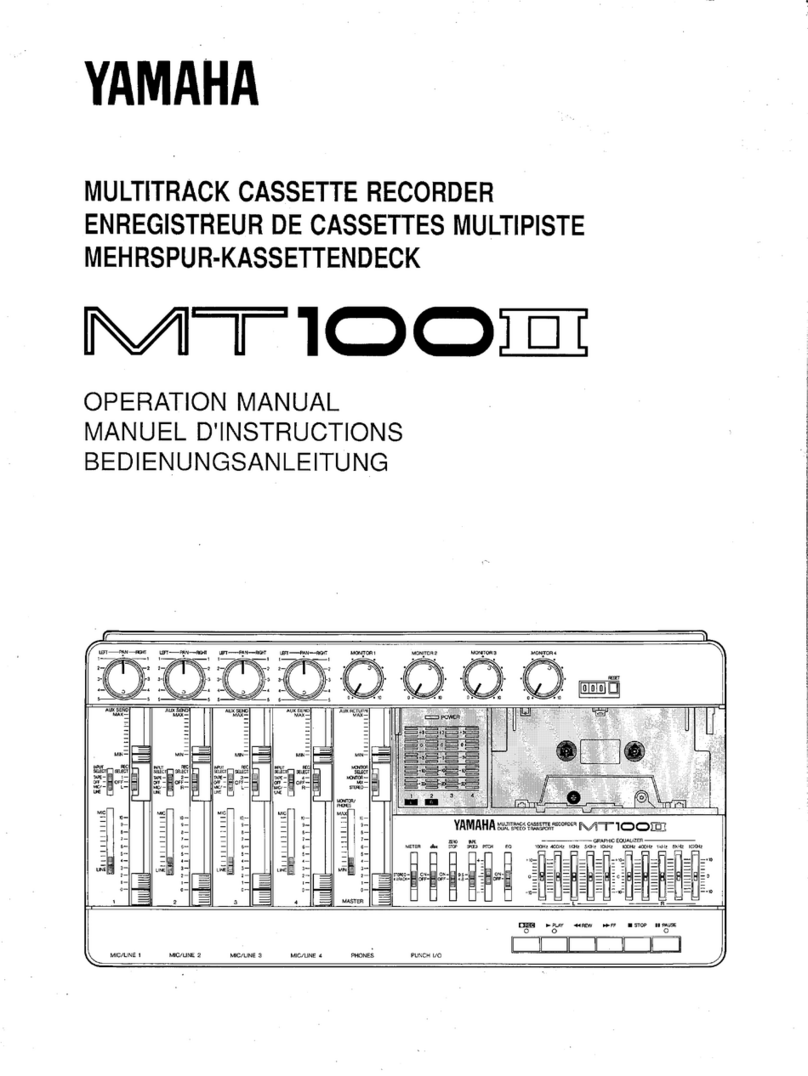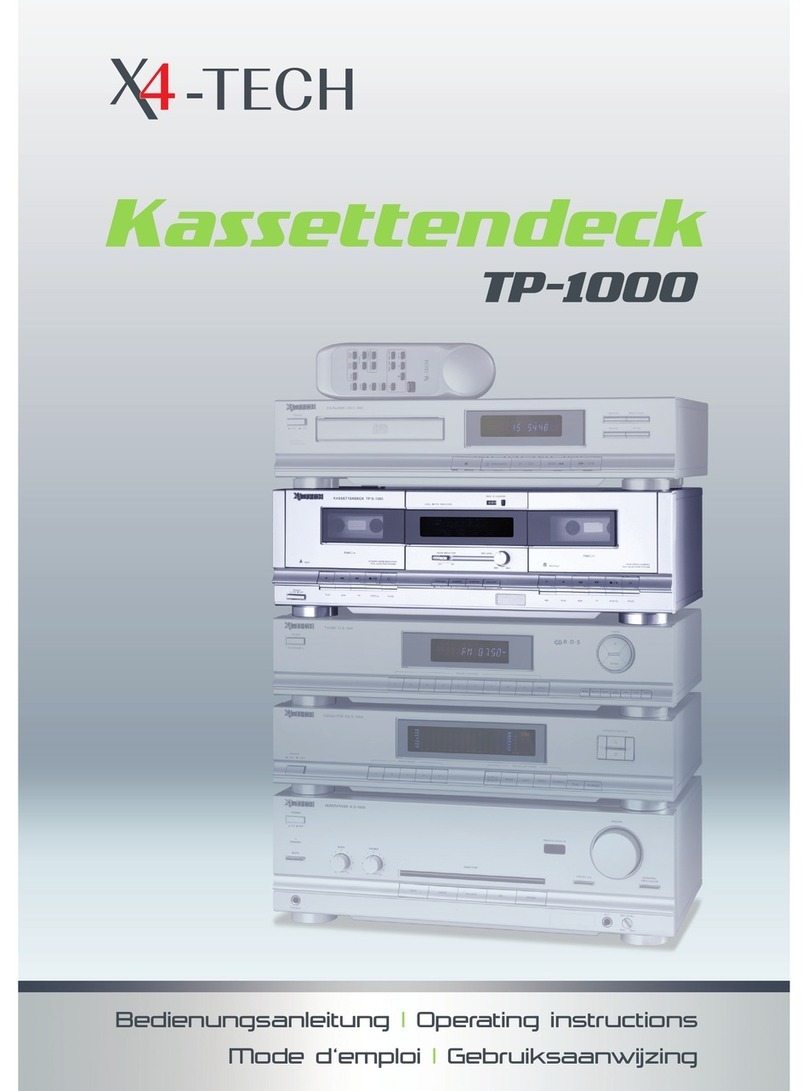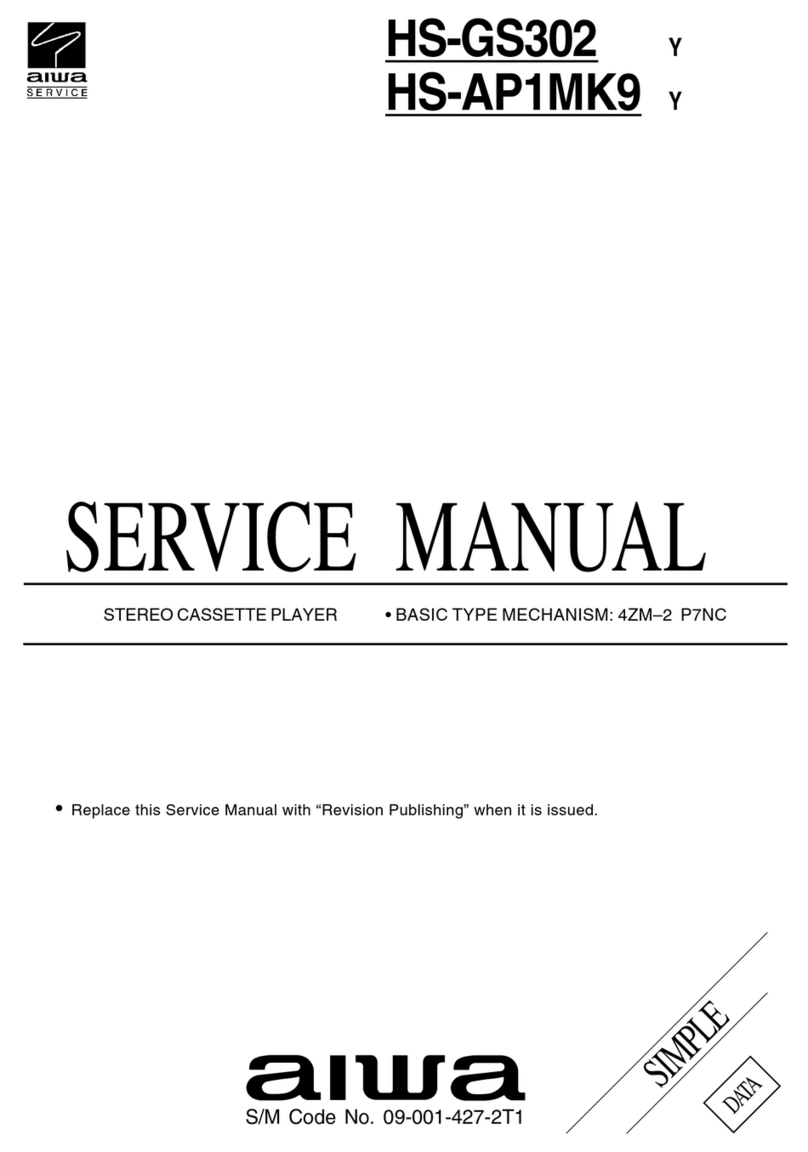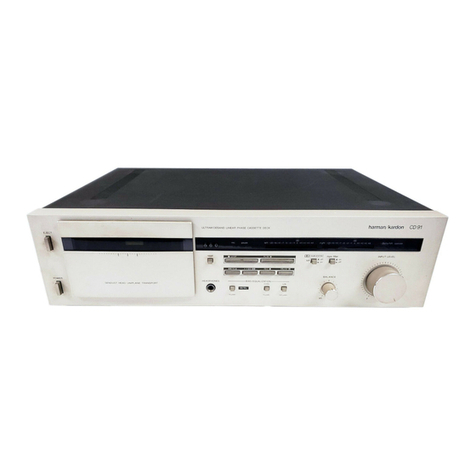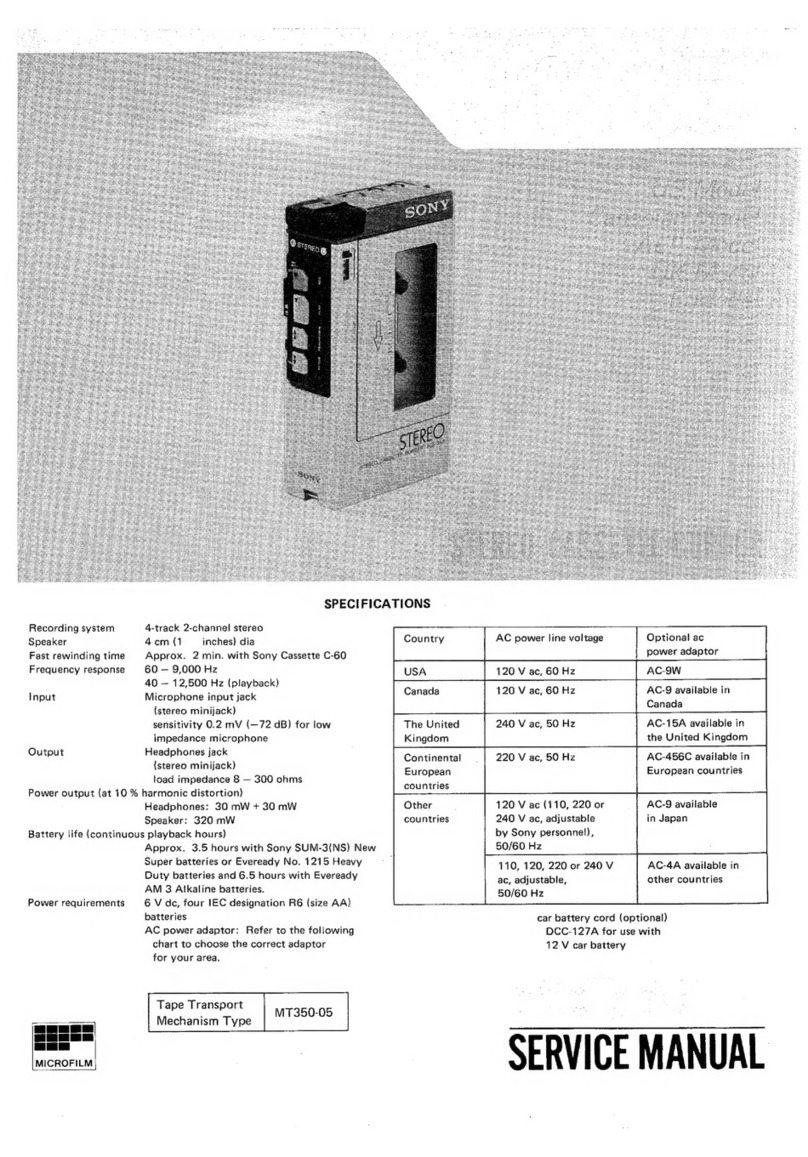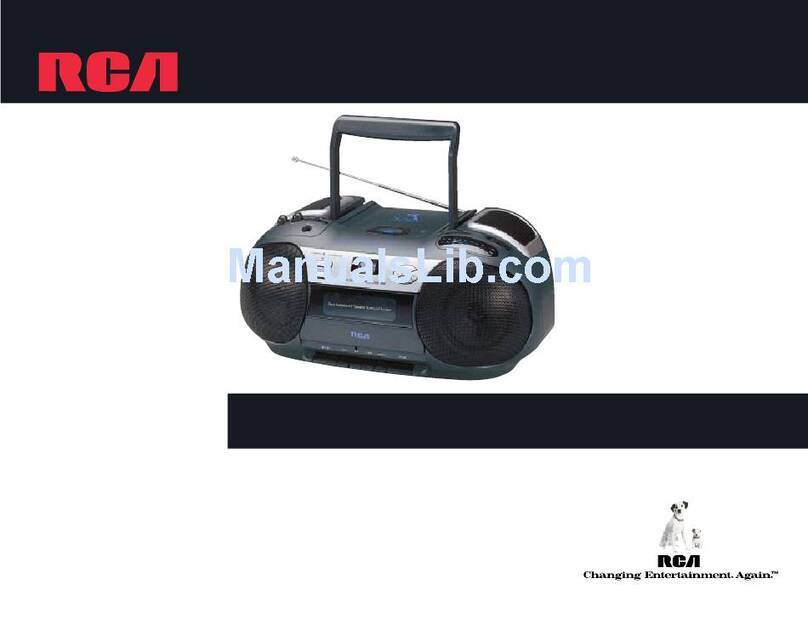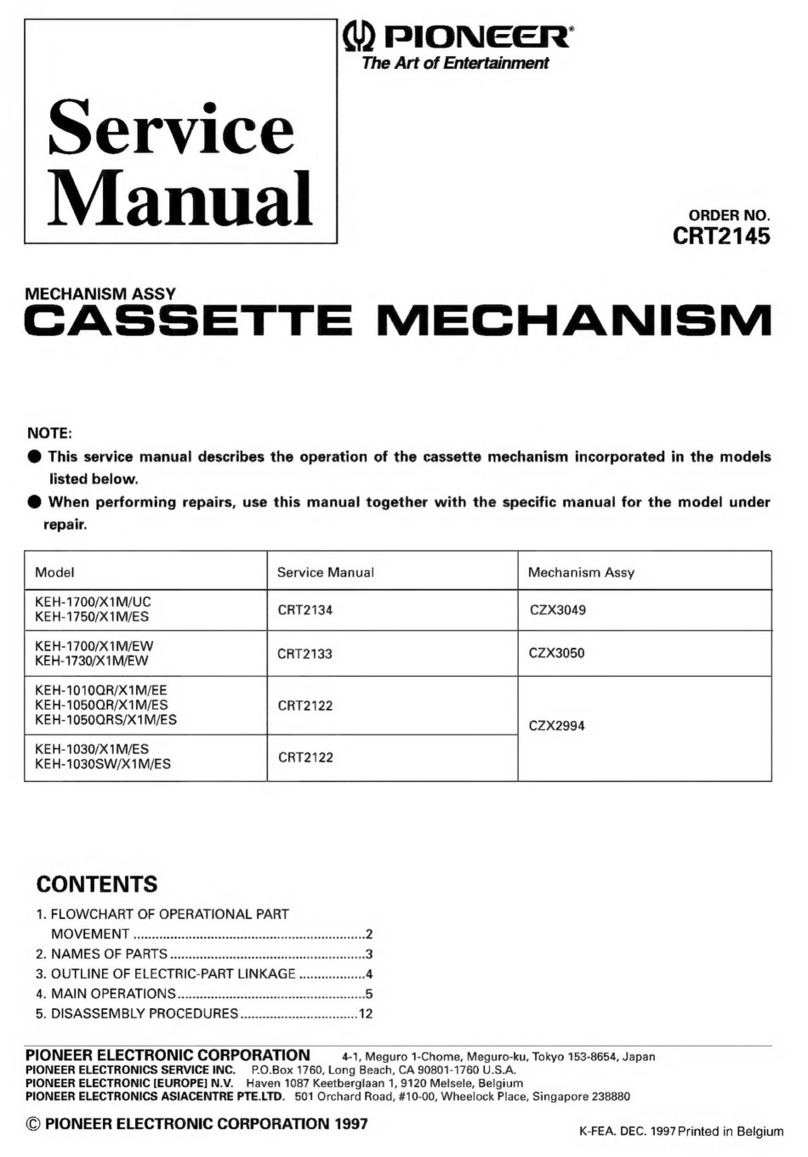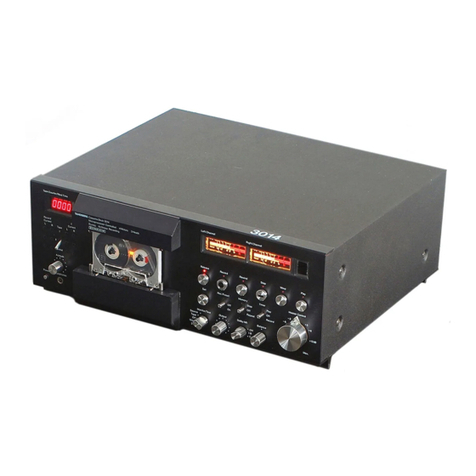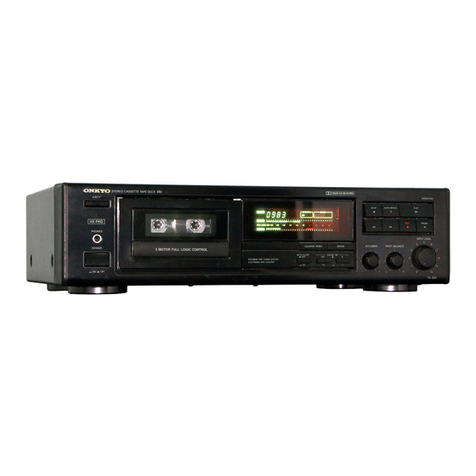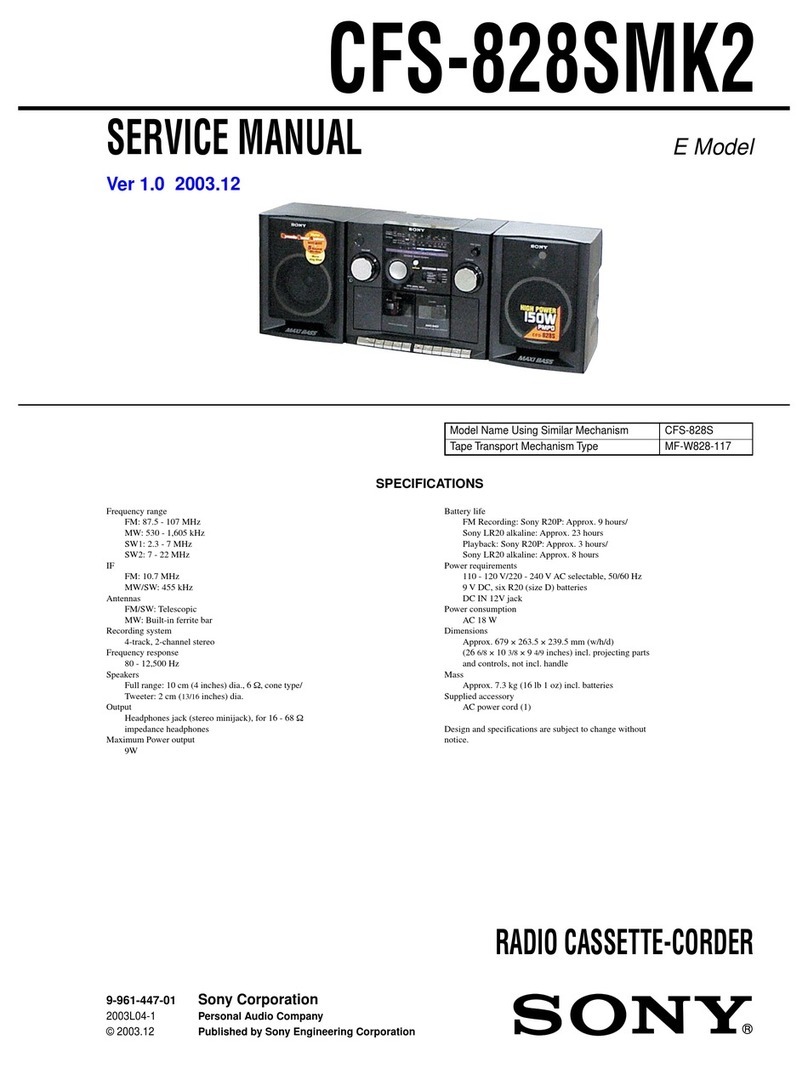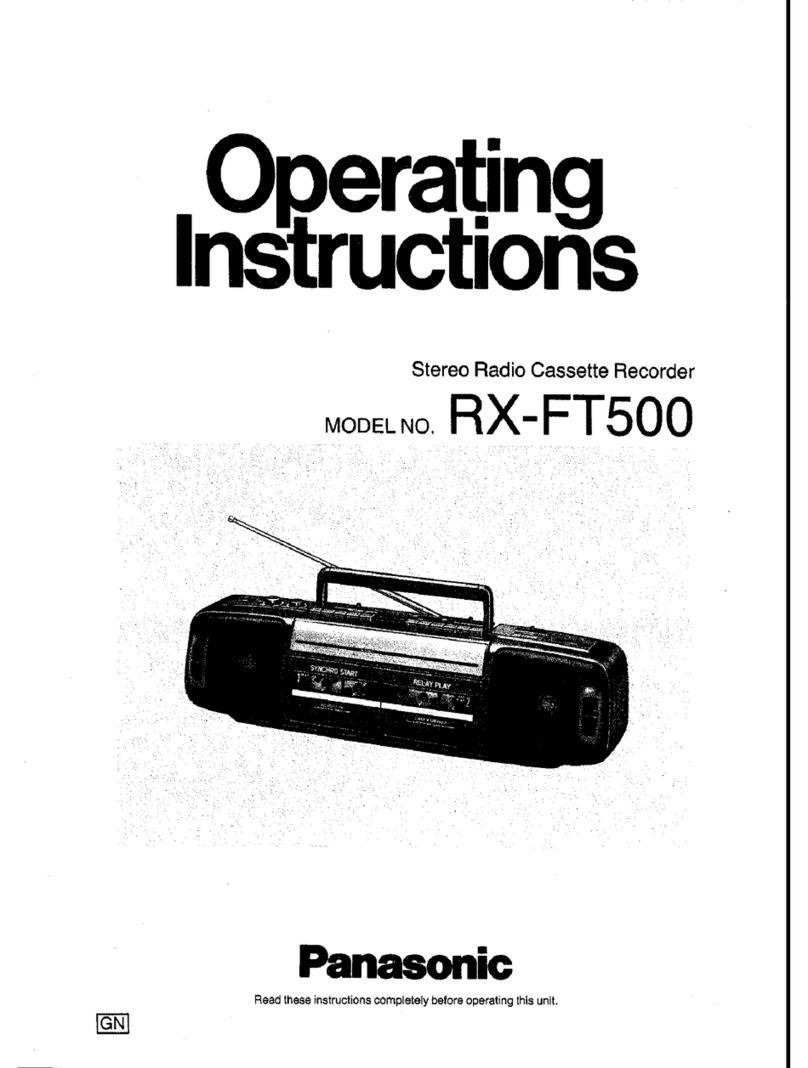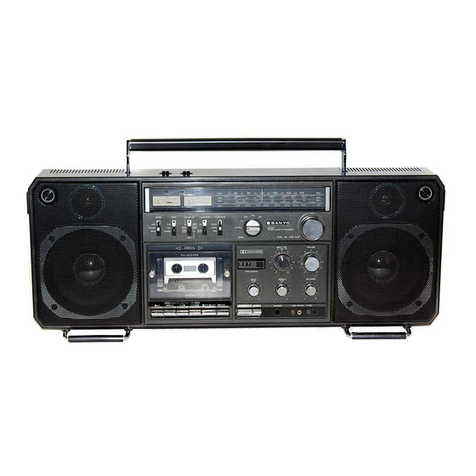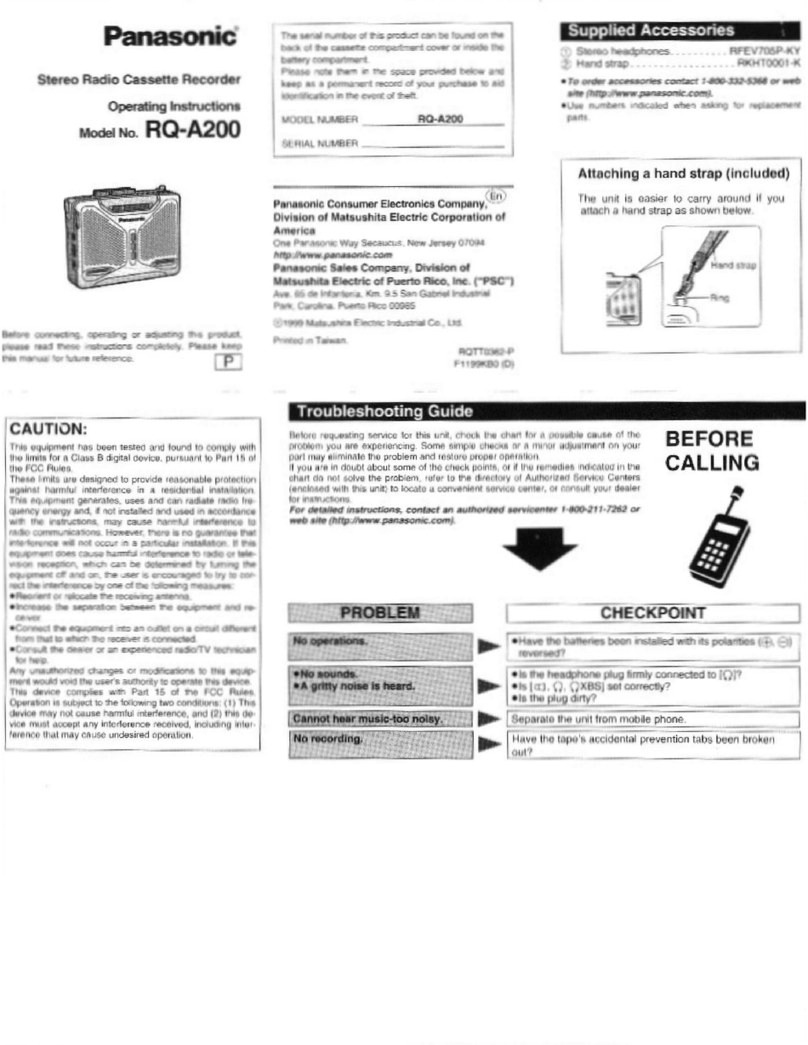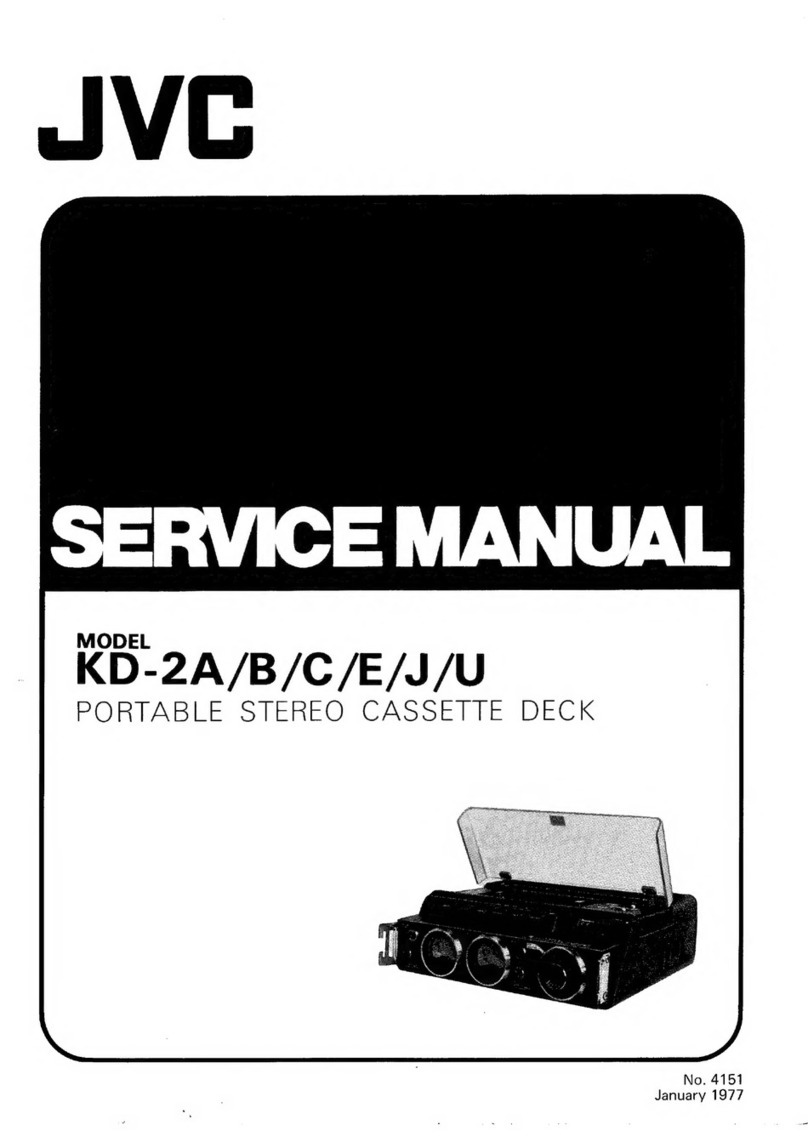Viking FF75 Series User manual

PnoToFACT* FolJ"* VIKING
MODEL FF75 Series
g
$i
a
o
.I L
o
ta
9t
4N
:-tL
l:E
5-
-Eto
o
=
! l::
ffi
GENERAL I NFORMAT ION
The Viking FF75 Series tape transport mechanism consist of the foiiowing types: FF?5
covers basic mechanism, I'F?5R indicates erase-record heads supplied, FF?5RM indicates
erase and record-monitor operation (3 heads), FF?5S indicates stacked stereophonic heads,
FF?5SU indicates stacked and staggered stereophonic heads, FF?5SR indicates stereophonic
head plus monaural erase-record heads, L suffix indicates tapelifter accessory and LP suffix
indicates tapelifter and pressure pad accessory.
The Viking FF?5 Series can be used with the Viking RPOI Record-Playback amplifier for
professional quality playback, recording and duplicating, or used with the PB60 Preamplifier,
for playback of recorded tape. These amplifiers are covered in this manual"
These recorders have two tape speeds, 7 L/2" andS 3/ 4" persecond" Usingboth tracks
of the tape, the recording time is as follows:
3 3/ 4" Speed 7 L/ 2" Speed
=
o
t'
Itt
r(
tr*
rll-
xz
"o
la
o
:.
o
UI
Reel Size
5" (600 ft. )
?" (1200 ft" )I hour
2 hours 1/ 2 hour
I hour
FF?5 Series is designed to operate on 60 cycle, 105-125 volts, AC supply only"
Manufactured by:
Viking of Minneapolis
3520 East 43rd Street
Minneapolis 6, Minnesota
fhis moteriol compiled ond published by
HOWAnD W. SAmS & CO., lNC., tNDtANApOItS, tNDIANA
Copytight 1957 . All Righh Rcscrved
lllTt I - 57 stt 344 totDER l5

T:ff*S *
-. @
w
FIGURE I
SPECIFICATIONS
Power Requirement: 110-volts, AC, 60 watts.
Tape Speed: 7-L/ 2 ips. (3 3/ 4" ipsspeed is available
by changing belt to smaller groove on motor pulley.
Not recommended for reproduction of frequencies
higher than 7500 cps.)
_Frequency Response: 50 to 15,000 cps plus al7-I/ 2
Ips Tape speed.
Signal-To-Noise Ratio: 45 db or better. (This char-
acteristic can be adversely affected by location of
transformer or other sources of strong magnetic fields
within 12 inches of the playback head or heads. )
Flutter: 0.3 per cent or less.
OPERATI NG I NSTRUCTI ON5
1. Plug in the AC cord at a 110 volt, 60 cycle
receptacle.
2. PlacetheTape Motion Control in the I'Sil stop
position.
3. Turn the AC switch on.
Threading The Tape-
1. Place a reel of tape on the left reel piate (27)
and an empty reel on the right reel plate (15) making
sure the reel slots engage the pins on the reel plates.
2. Unwind about 10" of tape frorn the reel. Hold
asectionof thetape straight with both hands and insert
the tape in the tape slot making sure the dull coated
side face in toward the head.
NOTE: This recorder uses Type I'Atr wound tape,
i. e. the dul1 magnetic coated side faces in-
ward on the reel. If the tape used is Type
"8" (coated side facingoutward) the recording
will be made at a very low sound level and
the playback will be almost inaudible.
3. Insert the free end of the tape into one of the
three radial sl.ots in the hub of the empty reel. Turn
the reel several turns, counterclockwise, until the
tape is secured to the reel and all slack is taken up
between reels.
To Record From Microphone-
l. Turn the On-Off control clockwise on the
Weight: 11 pounds.
Record Head Characteristics :
Track width
Gap width
D-C resistance
Inductance
Erase Head (if used):
Track width
Gap width
DC resistance
Inductance
Impedance
0.009 in.
0.0015 in.
300 ohms
290 mh at I kc
0. 125
0. 008
125 ohms
30 mh
10K at 30kc
39K at 100kc
Page 2

?:ffi
FI GU RE
amplifier used, and allow about thirty seconds for the
tubes to warm up.
2. Insert the rnicrophone piug into the I'Miket'
jack.
3. Place the Play-Record switch in the record
position.
4. Move the Tape Motion Control to the rtFt'
(forward) position.
5. Hold the microphone about six inches from
your mouth and speak in a normal voice. Adjusting
the "Volume" control causes the electronic eye i.ndi-
cator to respond. Check to be sure that the maximum
peaks do not cause the eye to close entirely. This
will. avoid saturation or overloading of the tape with
consequent distortion. Good recording is obtained
when the electronic eye indicator closes less than half
way on recording peaks.
To Record From Radio-
Recordings from a radio may be made by one
of three ways:
1. Place the microphone about 6rr to l2!t in front
of the radio speaker. Turn the radio volume control
to a normal level. Setting it to high will cause dis-
tortion. Turn the radio tone control to maxirnum
treble. Set the recording level and proceed with re-
cording as described under 'tTo Record From Micro-
phone". Thistype of recordingmaynot be .satisfactory
as other sounds may be picked up by the microphone
which as a result will be recorded on the tape.
2
2. Have a shielded cable made up with a two
conductor phone plug on one end and two alligator clips
on the other end. Connect the alligator clips across
the voice coil terminals on the radio speaker and
insert the cord plug into the ilinput jackil. Set the
radio and Volume and Tone controls as described
above. Set the recording level and proceed as des-
cribed under "To Record From Microphone.'r
3. Have a shielded cable with a two conductor
phone plug on one end and the other end connected
across the radio volume control. Insert the phone
plug into the "input jack". Set the recording leveL and
proceed with the recording as described under "To
Record From Microphone". The position of the radio
volume and tone controls has no effect on this set up
and may be set anywhere.
To Record Frory_.Phonograph-
1. If the phonograph being used has a standard
pin type plug on the pickup leads, insert it into the
"Radio-Phono" jack. Set the recording level and pro-
ceedwiththe recordingas described under "To Record
From Microphone".
To Record From Television-
1. Use one of the three methods described under
"To Record From Radio" andproceedwithtHe record-
ingas described under ilTo Reoord From Microphoneil.
Fast Forward And Rewind-
=
o
E
rtt
r(
rri
tt-
de
tn
o
=.o
n
High-speed forward or
by moving the control knob reverse can be obtained
(6) toward the head for
Page 3

rewindand all the way from the head for fast forward.
Movement of this control will wind the tape on the de-
sired reel at a high speed as long as the control is in
this position, This control is primarily used in 1o-
catingadesiredportionof arecordingin a few seconds.
To Play A Recory!!4g-
l. Thread tape as described under rtThreading
the Tape".
2. Turn control knob (6) to I'Forward'! and ampli-
fier to playback.
3, Adjust tlte t'Volumet'and t'Tonetr controls for
desired listening level.
To Edi.t And Splice Tape-
NOTE: Since it is impossible to edit and splice one
track without affecting the other, recordings
which are to be edited should be limited to
one trdck only.
l. Thetapemaybeeditedby cutting out unwanted
portions, or by joining selections into another sequence.
Announcements may be inserted between selections,
etc. Unused sections of tape can be spliced together
for re-use.
2. Forbestresults, cuttape at a slight diagonal,
join ends together with splicing tape on the glossy side
and trim off any excessive width.
Erasing Recorded Material-
Units having erase head the tape is erased auto-
matically when unit is in the record position, ff it is
desired to erase a recording without putting anything
on the tape follow the normal recording procedure,
but leave tJre "Volume" control set at its extreme
counterclockwise position.
ADJUSTMENTS
Removal Of Main Escutcheon-
To remove front panel, remove "tape feed com-
pensator", tapelifter (if used), the four panel retain-
ing screws at top and bottom edges and remove knob
from tape motion control (6). With motor turned off,
place tape motion control in forward position and lift
off panel (24).
Takeup Drive Belt-
If the takeup reel (20) does not drive properly,
loosen the idler bracket mounting screw (46) slightly
andmovebracketto right, increasing belt (13) tension.
NOTE: Tootighta belt will cause undesirable tension
on tape during play. Do not move arm so far
to right as to cause the lower corner to dig
intothe takeup reel hub when the Tape Motion
Control is placed in the rewind position.
Supply Reel Brake-
Place Tape Motion Control (6) in "Rewind" po-
sition, loosen brake bracket mounting screws (4?)
Blightly and so adjust bracket that pad (28) is just
clear of supply reel hub (2?). Tighten screw. With
this adjustment properly made the brake spring will
Page 4
be forced away lrom the bracket approximately L/ 64
inchwhenthe Tape Motion Control is in "Stop" position.
Rewind Drive Adjustment-
Set rewind drive adjustment nut (25) so that
spring (26) does not bear on bearing bracket when
Tape Motion Control is in "Stop" position. (This
adjustment must not be changed after setting supply
reel brake adjustment. )
Takeup Reel Brake-
No adjustment is provided or necessary. Fail-
ure could oceur only because of excessive wear or
damage to pad (18).
IIead Adjustments-
Head height is determined by fixed spacers.
(A thinner spacer is provided for erase head (21) be-
cause of added track width. ) Each head is factory
adjusted using a very high frequency alignment tape
and special indicators. Do not attempt azimuth ad-
justment unnecessarily.
To adjust head face parallel to tape, loosen
retaining nut slightly and, using constant frequency
tape, turn head (22) to obtain position providing maxi-
mum volume oscilloscope, or meter indication.
(Adjust azimuth before completely re-tightening nut. )
To adjust azimuth use a suitable allen wrench
andadjust.thetwo set-screws alternately for maximum
indication. A high frequency tape (at ieast 7500 cps)
is necessary for precise adjustment. Tighten retain-
ing nut and check to see that no reduction in output
results. Use of an oscilloscope or output meter is
essential. The procedure for adjustment of binaural
heads is indentical. An erase head requires no azimuth
adjustment. Merely position the head so face is paralLel
to tape.
Adjustment Of Tapelifter And Pressure Pad
Assemblies-
NOTE: Pressure pad assemblies can be used only on
binaurai or erase record head assemblies
(two heads). Thetapetifter mechanism, how-
ever, is adaptable to single head unit.
Adjust cam (53) on shift rod (14) so that it is
barelyin contact with lifter when Tape Motion Control
is in forward position. See that lifter assembly (in-
stalled after front panel is in place) is bottomed on
mounting screw. Bend tapelifter support slightly if
necessary to bring tapelifter fingers parallel to face
of head and approximately l,/16 inch above top of head
bracket (20) when Tape Motion Control (6) is in rtstop'
position, When installing or readjusting a pressure
pad assembly (5?) it may be necessary to bend the
pad holder spring (59). With the tape motion control
in the I'Forward" position, the pad rest squarely and
very lightly on the face of the heads and on the tape
path. No appreciable flexing of the springs should be
noticeableasthepressure pads are raised to the lifted
position. The mounting screw is accessible after the
panel is in place only if the tape motion control is in
the "StopI or t'Rewind" position,
Adjustment Of Tape Feed Compensator-
The purpose of the "tape feed compensatorl is
to absorb and average out the slight variations in tape

=o
('
llt
F<
TE
;6
u
o
=.o
ta
speed which can result from tape - sticking, cracked
of warped suppiy reel, or an unbalanced winding of
tape. Adjustment is not critical. The position of the
compensating spring (9) should be such that it clears
the supply reel (2?) bV approximately l/ 8 inch at its
unsupported end. The "tape feed compensatortt must
be installed after the front panel is in place.
Capstan Drive Belt-
To replace th.e drive belt (32), remove the three
nuts in the triangular capstan rear bearing plate (3?),
remove plate and loop new belt over motor drive
pulley (43). The large diameter groove is used for
7 L/ 2 ips and the smaller groove is used for 3 3/ 4 ips
operation. Place belt (32) over capstan flywheel (31)
and replace bearing plate (37). If capstan rear bear-
ing plate (3?)has been bent or is improperly installed,
binding may result with loss of proper playing speed.
TROUBLES
Fails To Rewind-
1. The small rubber ring (42) loose or broken.
To replace the ring, insert a small screw driver under
ring and slip it over drive ptrlley (43).
Wow-
l. Check for flat spots on pressure roller (3).
To replace pressure roller, pull off cap (1). If
additional grip ring is provided, rernove ring by
spreading with screwdriver. Take off felt washer (2)
and replace pressure rolter (3).
Fails To Takeup-
1. Takeup belt (13) loose or broken, replace belt
if broken.
2. If takeup reel (15) does not drive properly,
loosen the idler bracket mounting screw slightly and
move bracket (10) to right, increasing belt tension.
Recorder Fails To Playback-
1. Checkplayback-recordheadfor proper align-
ment.
2. Check the recorded tape to see that the dull
side of the tape faces the playback head (22).
Poor Frequency Response-
1. Accumulation of tape coating residue on the
record-play head.
(a) After the "Viking" has been used for
sometime, themanythousands of feet of tape
passing over the heads may have deposited a
film of gum dust and dirt on the laminations.
This film will reduce the efficiency of the
recorder. This accumulation of tape coating
residue and foreign rnaterial should be
periodically removed by the use of a small
I
w)i
. :! .,5
{i
%^
FIGURE 3
Page 5

9ii
/@ii
-6@ I
rl "-d
A PHOTOFACT "EXPLODED" VIE\Y
@ Howard W. Sams & Co., lnc. 1957
F I GU RE 4A . EXPLODED V I EW OF PA RTS ABOVE BASEPLATE .
Page 6

=
o
C'
ln
F
Tr=
rn-
ile
tn
o
=.
o
UI
@
6
v
@e
re
I
I
I
I
FIGURE 48. EXPLODED VIEW OF PARTS BELOW BASEPLATE.
Page 7

=
l T
I
&
o
hI
g
|n
ln
E
J.
t
A
z
J
e.
r4r (/l
lJ- \
=L'
O-E
=&,
^\Z (J
=rrt
aoJ
elrr
_J
o-J
A
xe,
5uJ
pz
=ur
Eo
\t
(n
t4t
00
3
F
e
llr
=
o
g
&,
ur
=
c,
o
le
vt
z
e,
F-
-d
OJ
e
c)
.t,
.E
(l)
o
a
3nE
&,8
o5
Fvi
Itl CR
r-3
tllr-
ttt o
4; nt
.
il
ttt
ct
E'r
(u
tg
=
r/t
J
o
E
l-
z
o
(J
o
O. t;
f!
L9
oo
5ct.
i3
Ee
p.= E
ofl;
F -(,
(J Er
<5E
+9o
q ur.g
(J.5E
EL
o:€
rr-E;
x;t
lJ- c E
o
>.=
'67
tntr
go\
o?
>.:
-f,
'Uo
oct
o.o
o(J
L,
(n
u,
o
=
(J
o-
(',
(-,
-
F-
J
o
&
F
LJ
IIJ
J
IJJ
[n
Z-
o1
lr Z,
E*
&;_
UIU
Ettril
a=b
aFj
<F$
hg
gf;
-lO
p;
Eo
f3
V)
ttl
F
o
z
uJ
4ro {i
raX
(o (o
Itt
.n
]J
cd
bo
CL
tr!
oo)
fr&
EE f'- cO
C;
tZ
o
'-F
,-d
o-
oo
LL
o
-oF
Ld
9<
-a-
F
o
o7
LF
ae.
6<
o-
F
z
UJ
=
Itr
L)
J
o
+-
.-LOF
<e.
CL
tu
u. OO
q7
3r
:d.
o<
=o-
s€
z.L
XE
A.
(}
z
tr
d,
t1 <
(J ^r
b\I
6,O -:
. (cd)
(\
,l >@
c6t
.d@
U
lll
cr$
!-'At
UO
>o
lfl
s@
e
o.
O<
gq
EO
F: t{
v,
ut
F
o
z
o
F
z.
tlt
{
ttt
u
J
4
tlt
al
o
uz
e,ts
o.
o.rMF
ENEE
,A r)r r; i
trt<FF
Qc0cQcc
r!O
zz
Et
A
Itr
"lE
zl
313
lo
6I
Fxga
S-a
l- Z. r-aoor9
dddd
v,
llr
o
z
z
o
J
tn
z
t{
+)
:si*
idvd
Loi'l o
-Q# N-
() d.r /
EHgH
.d ij dE
(5<kl <
E:
*3 cf ct
oo
dE
@+rO)e
-t{ 06: O
5z.>Z
3
z
u.r
=
llJ
(J
J]
o-l
lrll
*l
I
I
o
,Z
e,F
o-
mFof
TdE#
cti.iicali
H (JH (J
gz@z
F
<ci
uD z-
Op
e ,y.
<<
da-
u)
I
rt.)
c\l
c\o I co
li'" I
U)$EA
Fq<Fq
L\t
I
M
O
Q
Ir)
I
t-
{{
co
<ct
<z
9.F
tse
z<
llJ 6_
U
dd
oo
ofi-d
(Opdls
toro
nz nz
'-O
ZL
HE
5* t;E;
roto)
6d6tr
6il +r 6l +r
!i{ o$ o
AZ AZ
o
z
&,
tn
;ilN ilN
t
FUI
ur(J
.n Z.
H< La€ I
SHvh
o .q lo,4
rom6irl!
Ei gFq*Fq
dd
F
o
F
z
llt
=
tlt
L)
o-
ut
e.
l*laae
Er-
l**l
;FlC
5lrtr
FJI;;
r.ra
O
I
a
A
E
O
O
$
t-
<r
:
O
o
I
n
A
g
O
O
.+l
:
CO
O
O
I
a
A
n
O
O
<'l
:
r(:
O
{r <{
lt
E>
rd hJ
uo
Hct
o/-
JP
o-{
t/)A-
--e
oz
-.1 F
-, e.
*s
(n (A
lt
EE
t{F
$.{l
6a c\a
tt
cra ca
6a 64
cit 6A
ll
ca co
AA
(5()
CAA
srs
aa
DP
UO
co ca
OO
tt
QO
aa
<l
FI
<l
ol
r-l
zl
url
=l
u..l I
UI
<l
JI
o-l
*l
Hct
oz-
SE
o-{
u)4
tO coro
R EE
llr
Fl
F{ FE<
9e
<L
Or
-d.
3{
Oto
rll C{
Lra c\l
oo
=rr
1 E>
O tr{ fr{
oci
=z
{r
e, e.
rt Otl,)
r() C\
tl
Oro
r() 6\
lr
tra
FE{
o
r.O
6.I <,
:^r
YA
oE
E{ F,'
i-e
oz.
*k i grco
c\l oo c!
A OU
k F{E{
i^c, o
dry-z
gn3 r() c\l
: QlJ:
i\i tr? 6!
O E&
o om
9t
9E
rrr<
<q-
olr)
(o lr)6\1
qi
sr 3R
i.ri oa
Fq dd
z2
\IF
rls
>f;
o
z
tr
e.
F
J
ooooo!o
l(itrrrl?lr)6l
c\I C\t 61
o-
L) OOOOl'o
60 6t 6l l.(N g\
.. I
-f;i <n
d 6-1 6A tl
UU OC)
tn
uJ
F
o
z
IJJ
CL v
X
CO
llJ
.n
fk
q)
€
0)
d
F2
rn
uJ
F
o
z
u.t
G
F
t- E-- r--
xp>
c\t c\l 6l
UJ
v,
f,
Fr
!cd
m
,. hO
oY!D
:.1 ;I d
-'t.:
E. o"H
trts1
F{ or
o_ a
!r14d
A<tr]
E:
an
lII
o
z
o
z
lr|
{
ut
I
J
o-
tlt
e
d
ez
gt-
A;
b0 b0
oq)
E v E,-r
G\roc\r=
.L'J oA
61 6ac\r=
tttt
maaa
i-.t F F F<
omFan
crd
zz
Vr
HE
>{
()
z
e,
F
;
v,
=
t
o
b! bo
oo
RxFx
o6D .=
oqco6rX
fri co <l lJi co
fifitrfi
.n
4r
o
z
LII
o-
Foril
Fd
u
.n
f,
t<
q)
F
r*Q
o o!
.i 'i l!
g g'€
<<-E
$
!r i* cd
<<()
F: x6rl
PAGE 8

e,
Iu
=
o
e
&,
ttr
E
&
o
l&
vt
z
&,
l-
I
lo
lr7
irr
['
l.
loo
I 2z
lo
Irr
I Ld
lis
t-;
| 3z
I cu
<l at
3l 6f
c]I
n-l '
al =2
=l br-
url <d
ul -{
<l o-
Jl
6- l-
rul
ul 6o
I !Z
lo
l=E
lo{
l='
t-
I
I
t;
loz
lz*
lvs
lFf
I
I
rr)
<{
@
:
o
I-
tr
d,
cl
LJ
l!
af,
cr
,l
tlJ
.t
rAl
66
<O GE
U
t&
al, s6
>O
d(9
e
A3q
t-n
d {GIl
fre F{
v,
trl
o
z
o
9.
Fi
k
o)
cd
F
t{
d
&
F{
Q
A
n
bo-
8E
^S
vF{
Ef{
!ia
HA
d)a
tsu
io
d-L
AO
I2AV7
,*d
zz
YE
Ff
ttJ
z
G
o- #!
.H .d
}F
aa
E* c\t c\a
>E
vt.
t4t
o
I
CT
-l
l-
vt
il
(J
=
tll
E
*
G
t"
F-
c
!o
I
g
rn
tn
E
t
{J
ct\
o
trl
z
J
J
lrl
lJ
I
b
O" u;
TF
LC'
oo
bcL
$8
(n E.9
U,.E E
oEq
=:,iLJ ET
<:b
t3g
e€E
OL.
nLo
IJ-.*
LIr.E;
x;t
l&cE
lu
>.=
'6 .o
t, tr
go\
o?
>.=
l:,
'Uo
oo
o.o
OU
U
cA!
-u
@
3
E
.EI
&
G
o
(J
\I/ ,d
q)
.2
c,
v,
.E
ct
o
ttl
rr'rE
g,E
o=
Ftt
!3 _€
V7 t-
rllo
&;(!
=
E.
t,
q)
trtt
(E
ag
=
rt!
-l
o
e
l-
z
o
(.,
{n rn
ry! M,
&n
oE
ELJ
F-
*ft
eu
[Ju
wtr
UT
ad
afr
ZE
T:
it}
E
-J
qfl
h
&
&
tn
lu
F
o
z
cc
G
c
F
o
F
z
llr
{
llr
u
-I
o-
uJ
d,
nS
au 1-
J
JF
=t
CL
o
FZ
g
trt F
<d o-
ffc;
zZ
an
aE
3f
.lg
ZL
d,
5t
lu
I lIJ
.n la
r,lJ I
e, l__
ul
ola
l^
o
6(
*
c
fi
f-
ltr
aD a
c
Q
cd
tr
frE
bo
o
^,.MoVM-
qqERfiE :HEREEH
?9A A,h A A,A,A A A,A "\
H =E{ F E{ Fi F F{ F F{ F Fi F{
r.HlrEapqn eaomtrne
o
z
llI
{
lrt
u
5
a.
lrt
e,
HHgHKgEf,*excex
OrO
c\ 6D
rf rt4- 6l cr' $ rr: (O t'- @ O) C) < 6l
- -60 cr: 6a ca 6a 60 06 0a 6D .+ <1 $
an
llt
o
z
z
o
J
u,
z
o
l<
!
6s?* *
Lrd U- 'd
#tr.9tri;d
5 o* o.3o
o- ii!d!
d.d-z4a il a *-.
EXgXqX
6i6s.5!
Fl<hr<Fa<
Bt
=F
o?di
ooq)
fidtr
$r*+:trrp
<tt Ojl O=n O
?z>z>z
o
z
rtJ
=
ur
U
.J1
ct
uz
4|-
o-
eEi*S:S
ftrTtritr
9E=€.!ts
GZ@2@Z
<ci
t/D z-
Or-
E, e.
do-
NN
*r*
9V9
l'r) O tfJ
6tlrJ6I
l6at6at6/)
l.- tE- tt- |
stE:l$ca$ra
<Fq<k<Fq
llJ co
-<d
4z
gF
a- e.
z<
lLl o-
(J
ddd
ooo.)
_d^E_E
lfr+rXr()r
rototo
nz Az nz
r\O
zt-
Up
lrlo/,
>t ddd
oo0)
_fi^E_d
rOrXgt()u
loloro
mapaznz
l?o
IF
Il-
t<
9ll-
FI
{ Ir-ut
CE Ir/,|.J
laz
lH"
ildl ilN dlN
Mfi dMfi
a d., do d
rr)-d}4-cro-c
6rmrotac\rm
Ei sE*a*ta
trfifr
o
z
IJ,J
=
uJ
U
-t
o-
4t
&,
t-
{t
c\t(?l,nro
r.6I-Yi.oT,ot--
tq?mTr:dF..FLa
l*i3*lgl;*
H55E5gHHg5
dl
zT
r*l
3l
;
zl
-l
e, l
*l
e,
o
=
lrl
&
Ltl
ca 6a 6O
= P- o
' its a9!-aT
o g gY 3T3S*
3 = T EE'I: MLJJT
I I 6o I I 6a! NrlLrilrrcn
E H E H=EE SESSg
r- tr- tr- eil
E,^: f=J I=r5^ ^. =
TiYEYIYETYfYEEHEY
>?>T>>>f>E3Ef39f>
fl (J t'l O rd rd H O rr] fl U H Cf C.l C-l O ra
(JDopgL'op(5()a(JpaFS(5
I
Je,
d_t
&,a
n:f
uo
o
<t
a
U
c.J
OI
e
c)
I
o
A
€
(l)
(O
(5
r()
t-I
(o
a
rtt
r-.
O
O
O
I
a
A
FA
E-
$
A
F{
o
r.!)
I
(0
3
O
()
lti
a
A
c\l
O
I
A
Q
et
o
oI
u:I
A
6l
a
st
m
O
crt
o
c!I
a
e
6l
oI
n
A
m
uiA
$p$*
n+€+
p@pA
U>Uts
6D O.s!r *
OOOO
iqiq
Q co ttr co
AAACI
tr-
$
lg
!:rl) I
I I F<^
na*ts
A>{.o
trEAA
.$
V)
;AI
58
U()
6A
oF
roX
,ll
F{Q
NQ
i
o
rr)O
OO
lt
en
AA
m€
$*
rna
<t .d{
Fan
U()
€':t
9co
rla9
-l t
F{ (o
na
tfl-
OO
tt
OA
AA
EE
$
a
;AI
;JO
oo
60
o=
roX
tl
tt{ A
QA
o
r.o O
rl
AA
FlA
na
{t
6A
ct
a
O
L(i
I
@
a
rf)
o
o
O
oI
A
A
Fq
A
6l
e
p
(J
<{
I
ir<
e
I
z
co
co
AI
A
gt
9a
ur<
<c
OOa
orr)o
()b- o
lo(OE-
6it 61 c\l
OUO
6I
6l*
OOO-
. .L(i o
aO-Al
=61c\tc\r
OOUO
E-. t-
a$-$
-ooo
Ho..
$rf)cOt-
dHit
UUL)O
-O
..r{i
< 6.0
UO
o:
U
Io
z
F
l-
z
ll.J
=
IJJ
U
J
c
LIJ
d,
Hct
oa
SE
o-{
r.4l A.
rr) cttr
EE
lt
<F1
E{ F{
O
6\l
I
Fl
E{
9e
<L
Or
ryE
3f
rri
c\il
o Ao
(o -iv
C\l H6O
td r
A Fqts
oci
=z
{r
d, d,
i-< ll)
@ 6.!t
Y ;T
o Tr.
E oE
F{ F{ F{
!:
eJJ
oz.
3rl
."- I
-.tc ot
d-luzl
snsl
I
@
rr) c9 CfO
E\t 6l o.J
A OA
tq F{ fri
rO
od
I
e S=
AJ\ 14 co
o mO
tr no
5g
>L
9a
!!<
<o-
O
r(!
I rf:
<t C{ Or
(o >co
"l h"l
E AE
t4 d fr.
t)9
z'
ME
Ff
z
tr
d
F
J
orlfro OO
F-f-totr)r(ll'r
{i n{ c\l 6{ c\l S\
CL
Ues*g3
[< <E
€,,
ur il
t-z <FaC
or9
UO
<E
co
()
bDf
HEgHKegHEgTHTx
ttltttttttllti
QV)QV1 V)AV)AV)rnAAaa
E{ E.t t< E-'t E-{ E-{ F{ F{ F t{ F F ts F
cqnEopqFaFantrFqmeap
'^d
zz
UF
F3
t-
!
*61 6e$lrJ(Ol--@
6\ 6it 61 C\: 61 c\l g\r Ar
trdfitrddcd
PAGE 9

II
\t
\t
r,()
ci
U
F
z.
(,
u
a
q
vl
E
U
-
F
o
U
J
z.
=
z.
o
=
t/l
O
o-
o-5>
=FO
z.G*
gR=
s=3
9"6=
><)E
q:y*
E*n
e=E
6fiq
<oa<
=a=
r{
JU
<= <+
€
r
O
F
z.
o-
=
o
e.
L
o
u
e
=
u
=
+
€lafr
6-
=clb-.'
1o9
d q::: (r
^ 06
ts H- =
E
@
95 'q
*5-9
5.r{ <
=F;n
<o[;-
6
= <\
L e.=
F u=
3 Pa
Y
IJ
@
\z
o
Nt
N
Sr I
!)lw
f<5 l8
o. I
Ire\
fdl
\s.l
--11', *g=i
F=SF
E
s= ,, @
)a6r--L
rl(
ili
@
U
=
F
U
6
oo
@
'{Jt r
H@g ---fl*Jr,
rO
s@ i
N
c!El E]
@
a
6\
\E/
z,
&.
(9
U
(.) O
'o' v. I
6I I
---{A/#lr'l
5 @ l'l
l4J
J
co E
E
a
,uuu b
J
co @
u
@
@
o
z.
E
C'
@ls
@
F,
Osz o
--v$--llr,
@
----\nAr-
6\ \z
16l o
g/=
F@
\Az1y*
@E
HAI
le@
HF-
@
g l@, 1-.
==
i3 e3l- | -- 3
E; 'il l(9-
@EEII
r+ @+F
E;L @
re
=6?F[:"-r,
l\E/.q|
I-JF
F @++FF @
<-)t
<t) I
o>l
;=Tffir.
u6 itr
@
@
@
@
i-@
a]:, I
=rll-
E;ilffifu:
\--Lr=+/o
Ee iilil
=., I :',€
@
@
- {t'
H5
@
u u[-
ssl
,o ol
N RIn
< lE,
J
Ld s
(o
\
(\
il 5l Hlsil El Kl
ffi
(E, ffi
:l :l =l I ul ul u
E
@
u.
U
L
=
=
Y,
(J
6
J
o-
o
e.
O
(-)
U
d.
€
o-
d.
@
i---------
i i------ -----F----
ii {fir
ii = c*s
iiE
ii = krfb=-l E tf* @* e
ii!-\_'_f_%r, l= l_
il{ it 5 @ t: i
ii ? =*il
ii=r+ll+= F I Hi
ii<'ffir' I 95
i i _alry_+ fit Y_t I 3l= r
ii@+qs@F @ H I ;-6l
ii frr-v_----------T =-
i i f-,i-"P.,,@ l- |
ii l@@*\ @l$= E t
ii l rl
ii=A{rt' ; @ g
i i @ ff-J-=11,-
ii | {
ii [3'',
@
o-N
=T
=<r{
-ao
e
o- l:
=T
e4N
e
I
I
otr
ro
rl-l
=\)
r--Grt
--c--t\
_$l
o
rO
@
@
u
UI
N
qg
@
ro
o
o\z
o
N
,-1
GJ
@
:e; s J"" :@s s
I fo oo <'/)
r-i-
i'
lJ
lr
l>
luJ
l- E
---lFln'
E@
o
G,/
(
E
G
A
fll=)* \s
l.l F>
\{ffi|'F @
rr 6
HHI'' @;E 6
)ig e @ .";"u- ;
J--fu[, I ,-{:-- *
)+" @ rlr, "tl I t
'l lt lll=
v,
o
o
o
o
o
o
)
TIT t!
lr' l=
lv1
ts
l-
:)
6-
z.
' ril c'.t e
r \9= ff
lll LrJ e
tlt u)
il,!l''e
ili >- He
5 F pt
ili
rlr
rlr
rl{
E iil I
c
o@Y,
€
N
Y,
oo
N:z
6
N
:z
6
+!z
o
Io
o
€co
F
g
o
=
C.;
+
Y,
No
z
Rc
\o SZ
€Y,
o
N
N
:Z
o
o-
F
o
o
o
ts o
o
ts o
\o
+
)z
o
o
c+
O<
o
o
N
N
g+ SZ
€
N
O
€c
oq o- 5Z
€
N
:z
6
N
!z
€
No(J
z.
rq
.=
o- €c
rq 4
z. Y,
€
N
rZ
6
N:z
€
N
:z
o
L+
z. u
=
o, c
o
c
o
o
NL
zc
o
o(3
o
co
o
o
=
ts
s4
2
(J
z. c
o
N6-
F
o
o
=
oo
o
=\Z
o
N
N
(5
u
oE
u-
=+{(J
z
:Z
N
+
o
o
N
Y,
o
\o
+
5Z
c
o
o
N
'.N
q+
O< :z
co
N
c
U
o
=
Fo
ts
oo N=t
x
€x
N
ts
=
N
N
Nu
€q
><
€
=
q
F
N6
Page l0

6X4 12AX7
5879
CHASS IS P860 PREAMPLIFIER
:'.
I
.:
!
P860 PREAMPLIFIER
RP61 RECORD.PLAYBACK AMPLI FI ER
=
o
I
ttr
F<
TE
;6
t'l
o
=.o
gl
Page ll

cotton swab on the end of a toothpick and require no further attention.
carbon tetrachloride as the cleaner. Be
careful not to mar the laminations as they An occasional cleaning out of foreigrr matter
should be smooth to operate properly. under the Main Escutcheon (24) is desirable. and a
small drop of oil on the sliding lever members is ad-
2. To much or too little bias. visable.
(a) Thiscanbecausedbythe frequency vary- CLEANING
ing from the desired 60 to ?OKC. Check and
replace the faulty components. The record head (22), capstan (31) and pressure
roller (3) are subject to an accumulation of tape coat-
LUBRICATIQN ing residue, which is worn off the tape as it passes
these parts. Use a soft cloth and alcohol to clean the
All rotating parts are provided with generous head surfaces, capstan and pressure roller.
size oilite bearings, which are factory lubricated and
MECHANICAL PARTS LIST
Ref .
No. Part
No. Description Ref .
No. Part
No. Description
I
2
3
4
5
6
7
I
I
10
ll
t2
13
l4
15
16
1?
18
19
20
2I
22
23
24
25
26
27
28
29
30
3r
D346
D35?
D3I2
D35?
D-3428
D3I4A
D3l5
D339
D316
D332
D334
D36l
D34OB
?5 -5
75 -1
D33l
D318
D335XA
Retaining Cup
Felt Washer
Pregsure Roller
Felt Washer
Head Cover
Tape Motion Control
Tape Feed Compensator Includes
the following (?, 8 and 9)
Cover Retaining Screw
Spri.ng Cover
Compensator Spring
Idler Pivot
Idler
Spring
Takeup Belt
Control Link
Takeup Reel Hub
Takeup Reel Bearing
Control Arm
Brake
Spring
Bracket
Erase Head
Record-Playback / Monitor Head
Head Support Post
Main Escutcheon
Control Adjustment Nut
Control Spring
Supply Reel Hub
Supply Wheel Brake
Base Plate
Switch Cover
Capstan Assembly
32
33
34
35
36
3?
38
39
40
4T
42
43
44
45
46
47
48
49
50
5l
52
53
54
55
56
5?
58
59
60
61
D359
D325
D362CA
D333
D-368AA
D36BXA
Motor Belt
Motor Mounting Bracket
Shock Mount (3)
Washer No. 12 (6)
Nut No. 12-24 (3)
Outer Bearing Plate
Washer No. 12
Nut No. 12-24
Motor Assembly (Inctudes 33, 34,
35 and 36)
Fan (with set screw)
Drive Belt
Pulley
Supply Reel Bearing
Spring
Idler Mounting Bracket Screw
Brake Bracket Mounting Screw
Tapelifter Assembly Includes the
following:
Lifter Slide
Slidewasher
Lockwasher (2)
Slide-Mounting Screw (2)
Lifter Cam and Screws
Slide Tension Spring
LiJter Attachment Screw (1,
Tapelifter
Tapelifter, Pressure Pad Assy.
(Same as Item 48 except (56)
omitted and add the fotlowing: )
Lifter and Pad Holder Bkt.
PadHolder (Spring & Pad)
Pad Holder Mtg. Screw (l)
Pad Cover
Page 12
Table of contents

